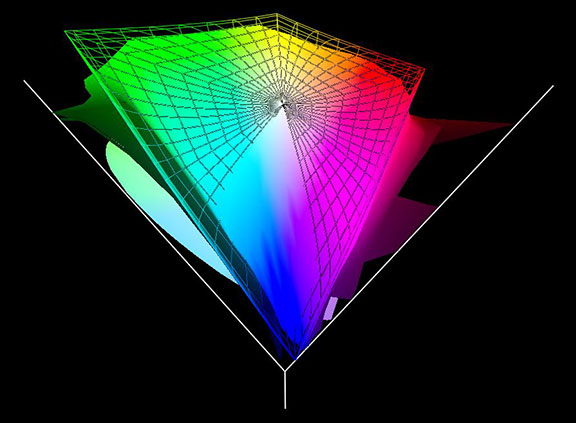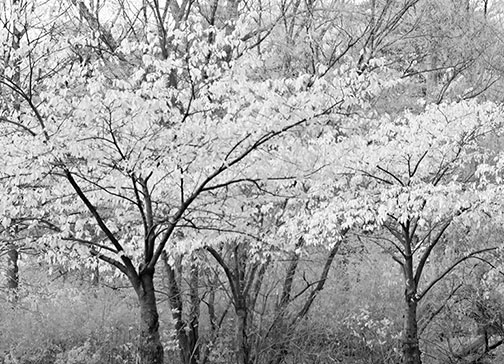
The wireframe in this 3D representation is the very large ProPhoto RGB colour space. It exceeds CIE LAB in all except a few areas (primarily the bluey / greens). The solid plot is that of the Leica M8. It clearly is almost as large as ProPhoto RGB (and is far larger than Adobe RGB) but what has caught my eye are the three spikes, one in the greens and the other two in the mauves and reds.
The extreme spike in the very deep reds indicates to me that the M8 has a very weak to nonexistent infra-red blocking filter. Does this mean that the M8 could be an ideal camera for doing infra-red photography, by just adding a visible light blocking filter?
The above is a quote from a section of myLeica M8 review. I had examined some of the profiles thatCapture Oneprovides for various cameras using theColorThinkprofile utility. What I saw was the the M8 appeared to have extreme sensitivity into the infrared portion of the spectrum. The gamut plot above shows this.
Since I have an interest in Infrared landscape photography, and hadconverted a Canon 20D to infraredearlier in the year, I was very curious to see whether my conjecture would pan out. The answer is –yes, and no. Yes, it is sensitive into the infrared, but no, it doesn’t do it particularly successfully.
______________________________________________________________________
Choosing a Filter
To be able to shoot infrared images on either infrared sensitive film, or a non-IR converted digital camera with IR sensitivity, requires a filter that blocks most or all visible light. The two most common filters for this task are the 89B and 87C. Below is the description taken from B+W’s technical literature on the difference between the two filters.
B+W Infrared Filter 092 (89 B) [RG 695]
The nearly opaque Infrared Filter 092, which looks dark purplish red when held in front of a light source, blocks visible light up to 650 nm, and passes only 50% of the radiation just below 700 nm (thus the dark red color). From 730 nm to 2000 nm, transmission is greater than 90%. This makes photographs of pure red and infrared images possible making the best use of the relatively low sensitivity of infrared films. As the sensitization of infrared black-and-white films barely extends beyond 1000 nm, the red portion that is transmitted still makes a relevant contribution to the exposure. This makes the 092 the preferred filter for pictorial photography on IR black-and-white film. Its filter factor is 20 to 40.
B+W Infrared Filter 093 (87 C) [RG 830]
This Infrared Filter blocks the entire visible spectrum, so to our eyes it looks completely opaque. Unlike the 092 infrared filter described above, it makes pure infrared photographs possible without any residual visible red component. Its transmission only begins to exceed 1% at 800 nm, rising to 88% at 900 nm, and remains that high far beyond the upper limit of sensitization covered by infrared films. This filter is used less frequently in pictorial photography because of the dramatic loss of effective ISO. But in the scientific field, materials research and forensics, transmission strictly limited to the infrared range is often important. The filter factor is somewhat dependent on the illumination and on the characteristics of the film.
In addition, the 091 Dark Red may be used for more subtle Infrared Black & White photography; it transmits more visible light from the red end of the spectrum than the 092.
I chose the 89B. I found one in stock atB&Hin 77mm size. I already had the Leica 48–67mm step up ring for use with a polarizer, and therefore only needed a 67-77mm step up to allow the filter to mount on my Tri-Elmar.
______________________________________________________________________
Shooting & Processing
The filter factor of the 89B is 20-40X, so even on a sunny day exposures were typically 1/15 sec at f/11 with the ISO set to 640. I found the need for f/11 as a minimum aperture because Leica lenses do not have infrared focusing scales, and therefore one has to guess at the correct focus point. So, a small aperture combined with a bit of focus bracketing is required.
As with my IR converted Canon 20D I found the best monochrome conversion tool to beAdobe Lightroom. Its grayscale mixer really makes the task simple and responsive. You can read more about conversion and other related topics onDavid Burren’s IR web site.
______________________________________________________________________
The Results

Infrared Sample. Toronto, November, 2006
Leica M8 with 28-35-50 Tri-Elmar @ 50mm. 1/45sec @ f/8. ISO 1250
From an inherent IR perspective the results are fine. The camera clearly records well into the infrared. From a practical usability perspective things are less rosy. To be able to hand hold at a medium to small aperture means ISO 640 and 1250, if not higher. Focusing is problematic because of the infrred shift, and in the end after a day of shooing I found hardly a single frame that was printable, just from a technical point of view.
If I had been willing to work on a tripod and do extensive focus bracketing I’m sure I would have come away with some keepers. I may yet do that experiment. But for the time being I’ve satisfied myself that the Leica M8 is usable as an infrared camera, but it’s just not as versatile as my IR modified DSLR for casual use.
November, 2006
______________________________________________________________________
Postscript
By coincidence, Sean Reid ofReidiReviewspublished on one of the online forums an official statement by Leica regarding the camera’s Infrared capabilities and the impact that this might have on normal photography. I am reproducing the pertinent part here.
The glass cover of the image sensor of the LEICA M8 is a combination of the IR barrier filter and a specially coated protective glass. The transmission in the red and infrared region of the spectrum can be controlled by the layer thickness of this filter. In the case of the Leica M8, which is a very compact system, the thickness of the filter, 0.5 mm has proved to be ideal. The short back focal length is the base for the compactness and the high quality of the standard and wide-angle lenses. However, the resulting oblique angle of the incident light on the sensor requires special adaptations of the filter.
Absence of color fringing / Image Resolution
The extremely thin layer of the filter, 0.5 mm prevents color fringing at the corners of an image. This phenomenon, which is also known as astigmatism and is frequently encountered with digital SLR cameras, is not a problem for the LEICA M8 because of the thin glass cover on the image sensor. This feature, plus the particularly high imaging quality of Leica M lenses, is the reason for the high corner-to-corner image resolution.Rendering of black synthetic fibers
The elimination of color fringing and the improvement of image resolution results in higher IR sensitivity. This causes some synthetic textiles to appear an artificial-looking purple.If the higher IR sensitivity has a disturbing effect in certain applications, e.g. fashion photography, LEICA Camera AG offers its customers a special IR barrier filter. This is screwed on in front of the lens and is an ideal combination of IR, UV and protection filter.
The use of the additional IR filter in front of the optical system has big advantages, as the filter does not create reflections inside the optical system. This enables the reproduction of the finest tonal values even in shadows.
The filter is supplied as an accessory with a special firmware adjustment, which will be available shortly after the planned market launch of the camera at the end of November 2006.
The IR/UV filter is only suitable for use with digital M cameras and 6-bit coded lenses.
The high IR transmission may also be a creative advantage for applications in the area of infrared photography.
You can read the entire statement and ensuing discussionhere.
Sean plans on doing tests soon of the B+W 486 IR Cut filters on the M8 to see how effective it is at dealing with the magenta cast issue.
You May Also Enjoy...
VJ12 – Video Clips
This Page Contains Links to a Few SelectedPreview Video Clips From The Current Issue ofThe Luminous Landscape Video Journal. These low-resolution video clips are in QuickTime
